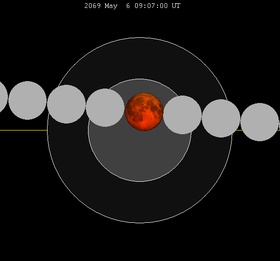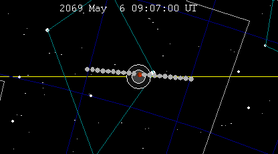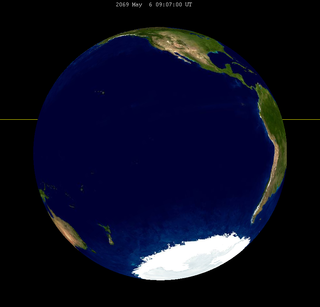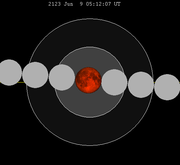- May 2069 lunar eclipse
-
Total Lunar Eclipse
May 6, 2069
The moon passes west to east (right to left) across the Earth's umbral shadow, shown in hourly intervals.Series (and member) 132 (33 of 71) Duration (hr:mn:sc) Totality 01:24:16 Partial 03:46:11 Penumbral 06:08:07 Contacts P1 06:03:38 UTC U1 07:14:38 UTC U2 08:25:35 UTC Greatest 09:07:43 UTC U3 09:49:42 UTC U4 11:00:49 UTC P4 12:11:45 UTC 
The eclipse occurs in the constellation Libra at the ascending node of the moon's orbit.A total lunar eclipse will take place on May 6, 2069. The eclipse will be a dark one with the southern tip of the moon passing through the center of the Earth's shadow. This is the first central eclipse of Saros series 132.
It is the first of two total lunar eclipses in 2069, the second occurring at the descending node of the moon's orbit will be on October 30th which will also be a central total eclipse.
Contents
Visibility
The eclipse will be visible after sunset over Australia and begin before sunset over far eastern Asia, and be seen in the predawn hours over western North and South America.

This simulated view of the earth from the center of the moon during greatest eclipse show where the eclipse will be visible on earth.The moon will also occult the bright star Alpha Librae as seen from the southern hemisphere a few hours before greatest eclipse.[1]
Related lunar eclipses
Lunar eclipses are related by many different eclipse cycles. The Saros cycle (18 years and 10 days) repeats the most consistently due three coinciding periods, and continue over 70 events (1200+ years). Eclipses are identified by a Saros number and a member index within each series.
The lunar year (354 days) and Metonic cycles (19 years) are short period last only 8 to 10 events. The Metonic cycle is equal to one Saros cycle plus one lunar year, and so the two series progress in parallel.
The Inex cycle (29 years minus 20 days) can last tens of thousands of years, so long that long perturbations in the moon's path must be taken into account for prediction. Also the eclipse qualities are less inconsistent because the moon is at different significantly positions in its elliptical orbit in sequential events. Similarly for the shorter Tritos cycle (10 years and 31 days), repeats less consistently for the same reason.
Lunar year series
This eclipse is the third of four lunar year eclipses occurring at the moon's ascending node.
The lunar year series repeats after 12 lunations or 354 days (Shifting back about 10 days in sequential years). Because of the date shift, the Earth's shadow will be about 11 degrees west in sequential events.
Lunar eclipse series sets from 2067-2070 Ascending node Descending node Saros Date
ViewingType
ChartSaros Date
ViewingType
Chart112 2067 May 28

Penumbral

117 2067 Nov 21

Penumbral

122 2068 May 17

Partial

127 2068 Nov 09

Total

132 2069 May 06

Total

137 2069 Oct 30

Total

142 2070 Apr 25

Penumbral

147 2070 Oct 19

Partial

Metonic series
The Metonic cycle repeats nearly exactly every 19 years and represents a Saros cycle plus one lunar year. Because it occurs on the same calendar date, the earth's shadow will in nearly the same location relative to the background stars.
This series has 9 events centered on May 6th and October 30th: (saros number)
Ascending node Descending node - 2031 May 07 - penumbral (112)
- 2050 May 06 - total (122)
- 2069 May 06 - total (132)
- 2088 May 05 - partial (142)
- 2107 May 07 - penumbral (147)
- 2031 Oct 30 - penumbral (117)
- 2050 Oct 30 - total (127)
- 2069 Oct 30 - total (137)
- 2088 Oct 30 - partial (147)
Saros series
Lunar saros series 132, repeating every 18 years and 11 days, has a total of 71 lunar eclipse events including 12 total lunar eclipses.
Greatest First 
The greatest eclipse of the series on 2123 Jun 9 will last 106 minutes.[2]Penumbral Partial Total Central 1492 May 12

1636 Aug 16

2015 Apr 4

2069 May 6

Last Central Total Partial Penumbral 2177 Jul 11

2213 Aug 2

2429 Dec 11

2754 Jun 26

There are 11 series events between 1901 and 2100, grouped into threes (called an exeligmos), each column with approximately the same viewing longitude on earth.
1901–2100 1907 Jan 29 1925 Feb 8 1943 Feb 20 





1961 Mar 2 1979 Mar 13 1997 Mar 24 





2015 Apr 4 2033 Apr 14 2051 Apr 26 





2069 May 6 2087 May 17 



Tritos series
The tritos series repeats 31 days short of 11 years at alternating nodes. Sequential events have incremental Saros cycle indices.
This series produces 20 total eclipses between April 24, 1967 and August 1, 2167, only being partial on November 19, 2021.
Tritos eclipse series (subset 1901–2100) Descending node Ascending node Saros Date
ViewingType
chartSaros Date
ViewingType
chart115 1901 Oct 27

Partial

116 1912 Sep 26

Partial

117 1923 Aug 26

Partial

118 1934 Jul 26

Partial

119 1945 Jun 25

Partial

120 1956 May 24

Partial

121 1967 Apr 24

Total

122 1978 Mar 24

Total

123 1989 Feb 20

Total

124 2000 Jan 21

Total

125 2010 Dec 21

Total

126 2021 Nov 19

Partial

127 2032 Oct 18

Total

128 2043 Sep 19

Total

129 2058 Jun 6

Total

130 2069 May 6

Total

131 2080 Apr 4

Total

132 2091 Mar 5

Total

Inex series
The inex series repeats eclipses 20 days short of 29 years, repeating on average every 10571.95 days. This period is equal to 358 lunations (synodic months) and 388.5 draconic months. Saros series increment by one on successive Inex events and repeat at alternate ascending and descending lunar nodes.
This period is 383.6734 anomalistic months (the period of the Moon's elliptical orbital precession). Despite the average 0.05 time-of-day shift between subsequent events, the variation of the Moon in its elliptical orbit at each event causes the actual eclipse time to vary significantly.
All events in this series listed below and more are total lunar eclipses.
Inex series from 1000 to 2500 AD Ascending node Descending node Ascending node Descending node Saros Date Saros Date Saros Date Saros Date 96 1027 Apr 23 97 1056 Apr 2 98 1085 Mar 14 99 1114 Feb 21 100 1143 Feb 1 101 1172 Jan 13 102 1200 Dec 22 103 1229 Dec 2 104 1258 Nov 12 105 1287 Oct 22 106 1316 Oct 2 107 1345 Sep 12 108 1374 Aug 22 109 1403 Aug 2 110 1432 Jul 13 111 1461 Jun 22 112 1490 Jun 2 113 1519 May 14 114 1548 Apr 22 115 1577 Apr 2 116 1606 Mar 24 117 1635 Mar 3 118 1664 Feb 11 119 1693 Jan 22 120 1722 Jan 2 121 1750 Dec 13 122 1779 Nov 23 123 1808 Nov 3 124 1837 Oct 13 125 1866 Sep 24 126 1895 Sep 4 127 1924 Aug 14 128 1953 Jul 26

129 1982 Jul 6

130 2011 Jun 15

131 2040 May 26

132 2069 May 6

133 2098 Apr 15

134 2127 Mar 28 135 2156 Mar 7 136 2185 Feb 14 137 2214 Jan 27 138 2243 Jan 7 139 2271 Dec 17 140 2300 Nov 27 141 2329 Nov 7 142 2358 Oct 18 143 2387 Sep 28 144 2416 Sep 7 145 2445 Aug 17 146 2474 Jul 29 See also
Notes
- ^ Jean Meeus , G. P. Konnen, Occultations of Bright Stars by the Eclipsed Moon, Journal of the British Astronomical Association, Vol. 85, No. 1, pp. 17-24 (1974).
- ^ Listing of Eclipses of series 132
External links
References
- Bao-Lin Liu, Canon of Lunar Eclipses 1500 B.C.-A.D. 3000, 1992
Categories:- Lunar eclipses
- 2069 in science
- Lunar eclipse stubs
Wikimedia Foundation. 2010.
